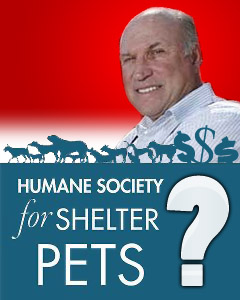 Yesterday we examined a new organization, the Humane Society for Shelter Pets. If you’re not familiar with their high-priced campaign of deception against the Humane Society of the United States, read our previous article for the background.
Yesterday we examined a new organization, the Humane Society for Shelter Pets. If you’re not familiar with their high-priced campaign of deception against the Humane Society of the United States, read our previous article for the background.
The Humane Society for Shelter Pets (“HSSP”) says they have no connection to the anti-animal welfare organization, the Center for Consumer Freedom. We find this assertion a little… shall we say, less than credible?
Here’s why.
HSSP has hired Berman & Company to run their organization’s public relations and marketing campaign.
Berman & Company is a major (and very expensive) lobbying firm in Washington, D.C.. The company is the brainchild of Richard Berman, a well-known lobbyist sympathetic to the concerns of anti-social corporate interests and anti-animal causes. The Center for Consumer Freedom (“CCF”) is a major client of Berman & Company, paying them a tidy sum of $1,461,597.00 for “management services” last year — not including Berman’s salary as “Executive Director” of CCF.
The services of Berman & Company do not come cheap. And they don’t work for free. Yet it would appear that HSSP has no problem affording this very expensive corporate PR firm.
If HSSP had been around for a while, and had time to build up a substantial donor base, this little fact would be less interesting. However, in its very first week of existence, HSSP was able to afford the services of one of Washington, D.C.’s most expensive, most infamous PR firms.
Ironically, HSSP claims to exist for the purpose of helping get donations to local shelters. The presumably hefty fees they are paying Berman & Company could help a lot of shelters, but instead this supposed non-partisan non-profit has chosen to use that money to attack a major animal advocacy and welfare group.
So, inquiring minds wanted to know, where is HSSP getting their operating money from?
Veterinary Practice News covered the debut of HSSP, and dropped a clue to one possible source of HSSP’s funds:
The organization is funded by individuals, corporations and foundations that are supporters of the pet industry, according to HSSP co-director Jeff Douglas.
Which “supporters of the pet industry” would have both money to burn, and a burning grudge against the Humane Society of the US? Could it be the puppy mills and irresponsible breeders who account for more than a quarter of the pets in shelters?
Exotic pet breeders and their trade groups aren’t happy about the HSUS pointing out the dangers of having a tiger in your backyard.
Shamed pet store chains who purchase from pet mills and perpetuate the puppy mill trade have an axe to grind too.
HSSP, as is usual in Berman’s long line of nonprofit puppet websites, have not disclosed exact sources of their funding, as is common among most legitimate nonprofits. Nor do they seem to be in any hurry to do so. Which leads one to wonder: Why so secretive?
What, exactly, does the Humane Society for Shelter Pets have to hide?
Update: HSSP’s Form 990 tax returns have been released, and to no one’s surprise, Richard Berman’s name appears on the form — along with $765,000 in payments to Berman and his for-profit PR firm.
 Imagine spending your life crammed into a space about as big as an airline seat.
Imagine not being able to turn around, to roll over, or to stretch your limbs comfortably.
Imagine being so frustrated and stressed by being forced to live like this that you bite the bars of your cage (because that’s the only thing you can get to) until your mouth bleeds.
Imagine the suffering…
For millions of pigs in gestation crates, this is not make-believe. It’s how they are forced to spend most of their lives, day in, and day out, for months at a time.
As you may already know, gestation crates are intensive confinement systems used in hog farming. They’re used to restrain a pregnant sow until she gives birth. Gestation crates typically measure 2 x 6.6 feet, barely larger than the sow.
Since the purpose of a factory farm sow is to produce litter after litter, as often as possible, this is where she will spend most of her life — until the final few months when she is fattened for the walk to the slaughterhouse floor.
Agricultural industry groups attempt to defend the cruelty of gestation crates by claiming that they are superior to group housing. But the research does not support their point of view. In fact, agricultural expert Temple Grandin unambiguously rejects gestation crates:
Imagine spending your life crammed into a space about as big as an airline seat.
Imagine not being able to turn around, to roll over, or to stretch your limbs comfortably.
Imagine being so frustrated and stressed by being forced to live like this that you bite the bars of your cage (because that’s the only thing you can get to) until your mouth bleeds.
Imagine the suffering…
For millions of pigs in gestation crates, this is not make-believe. It’s how they are forced to spend most of their lives, day in, and day out, for months at a time.
As you may already know, gestation crates are intensive confinement systems used in hog farming. They’re used to restrain a pregnant sow until she gives birth. Gestation crates typically measure 2 x 6.6 feet, barely larger than the sow.
Since the purpose of a factory farm sow is to produce litter after litter, as often as possible, this is where she will spend most of her life — until the final few months when she is fattened for the walk to the slaughterhouse floor.
Agricultural industry groups attempt to defend the cruelty of gestation crates by claiming that they are superior to group housing. But the research does not support their point of view. In fact, agricultural expert Temple Grandin unambiguously rejects gestation crates:

 After evaluating Center for Consumer Freedom (CCF) tax returns,
After evaluating Center for Consumer Freedom (CCF) tax returns,  Bloomberg News has issued a report into the potentially criminal activities of Berman and Company, Inc. and its nonprofit front groups. The report highlights Berman’s legal troubles and questionable activities.
Berman, unsurprisingly, had no comment.
Read the full article at
Bloomberg News has issued a report into the potentially criminal activities of Berman and Company, Inc. and its nonprofit front groups. The report highlights Berman’s legal troubles and questionable activities.
Berman, unsurprisingly, had no comment.
Read the full article at  Have you ever been struck by the sense that you’ve seen this all before?
Have you ever been struck by the sense that you’ve seen this all before? Yesterday we examined a new organization, the Humane Society for Shelter Pets. If you’re not familiar with their high-priced campaign of deception against the Humane Society of the United States, read our
Yesterday we examined a new organization, the Humane Society for Shelter Pets. If you’re not familiar with their high-priced campaign of deception against the Humane Society of the United States, read our